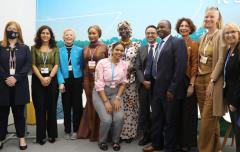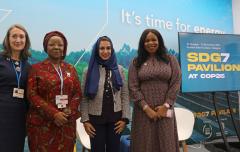SDG7 takeaways from COP26
COP26 has ended with the Glasgow Climate Pact calling on all 197 countries to accelerate efforts on climate action, keeping the hope of capping global warming at 1.5 degrees alive with new and updated NDC and net-zero commitments. Experts agree that this Pact is not enough and that we need much more ambition, finance, and action in this decade to have a fighting chance at achieving net-zero by 2050.
However, all hope is not lost. Over the course of two weeks, we saw several instances of raised ambition from governments and the private sector, committed to accelerating climate action and just transitions.
More specifically, on the main stage on Energy Day and at the SDG7 Pavilion, for the first time, we saw clear commitments focused on energy – the largest contributor to emissions and an important contributor to the blueprint for a sustainable and more prosperous future for all. An important signal was sent in simply having an SDG7 Pavilion for the first time at a COP, which was hosted by Sustainable Energy for All (SEforALL) in partnership with the Global Energy Alliance for People and Planet (GEAPP) and with the support of the UN. While we still have a long way to go, and there is disappointment and frustration at the final outcome, especially by climate-vulnerable countries already dealing with the effects of climate change, here are seven ways in which COP26 has left us poised for action, putting us on a pathway to achieving SDG7 by 2030 and a cleaner, healthier planet by mid-century.
1. Elevating the conversation on clean energy and energy access
For many, COP26 represented a turning point. With less than 9 years to make deep emissions cuts and deliver on SDG7, countries were asked to think long and hard to deliver ambitious updated NDCs – and energy systems were crucial to these commitments. Earlier in the year, at the UN High-level Dialogue on Energy convened by the UN Secretary-General, countries, companies, and other stakeholders were asked to make clear, trackable commitments in the form of Energy Compacts.
And at the SDG7 Pavilion, SEforALL, GEAPP and other partners sustained this urgency and continued to elevate the conversation around the importance of action on SDG7 and its critical impact on achieving net-zero targets. In addition, a dedicated and main stage Energy Day put the focus on the critical role of clean energy transitions that encompass energy access goals within the climate action agenda.
The Global Roadmap for Accelerated SDG7 Action in Support of the 2030 Agenda for Sustainable Development and the Paris Agreement on Climate Change officially released by UN Secretary-General, António Guterres, on the side-lines of COP26 was another milestone demonstrating unequivocal support for clean energy as the golden thread tying our collective climate and development goals together.
2. Ensuring a just and equitable energy transition
A critical piece of COP26 negotiations focused on balancing the need for developing and emerging countries to respond to the aspirations of their populations by providing sufficient and reliable energy for development with ensuring an energy transition that would put the world on a pathway to net-zero before it’s too late.
We cannot get to net-zero collectively unless we also factor equity into the conversation. The Glasgow Climate Pact includes multiple references to just transitions, including “finance flows consistent with a pathway towards low greenhouse gas emissions and climate-resilient development in a transparent and inclusive manner in the context of sustainable development and poverty eradication”. But there is very little by way of actual commitments made towards achieving this.
However, on a positive note, countries deeply embedded in fossil fuel energy systems, Nigeria and India, made net-zero commitments supported by evidence and commitments that they had put forward at the UN High-level Dialogue on Energy in September 2021. Similar commitments were made by Thailand, Nepal and Vietnam. This now means that nearly 90 percent of the global economy is covered by net-zero commitments. The Energy Transition Council, championed by the COP26 Presidency and supported by SEforALL, will continue at least until COP30 in 2025 to provide a platform for the global community to support these and other developing countries in meeting these targets and achieving a just energy transition.
3. Ending coal-fired power?
It is heartening that for the first time ever, coal has been explicitly mentioned in COP documents and significant commitments were made to transition away from coal, as well as end the financing of coal power abroad. More than 40 countries signed up to a political declaration on Energy Day to transition away from unabated coal power generation, and although the final Glasgow Climate Pact had language changed from ‘phase out’ to ‘phase down’, this is still important progress. This builds on the momentum of the No New Coal Energy Compact commitment presented by Sri Lanka; Chile; Denmark; France; Germany; United Kingdom and Montenegro at the UN High-level Dialogue on Energy, responding directly to the Secretary General’s call for halting all new coal-fired power production.
There were significant commitments on the side-lines of the official negotiations, including 28 new members joining the Powering Past Coal Alliance – the world’s largest alliance on phasing out coal – taking the number to more than 160 countries, sub-national governments, and businesses.
Banks and financial institutions made commitments to end the funding of unabated coal. These complement announcements made earlier in the year by China, Japan and South Korea to end overseas coal financing. Additionally, a group of 25 countries signed a UK-led joint statement committing to ending international public financing for the unabated fossil fuel energy sector by the end of 2022, prioritising support for clean energy instead. This functionally ends almost all concessional or public financing of international coal power. The Climate Investment Fund and Asian Development Bank also announced partnerships supporting accelerated transitions away from coal power. While there are still plenty of questions on the robustness of these commitments, as the UNFCCC has stated, the days of coal as a viable energy choice are numbered.




